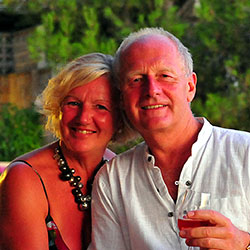In Réunion you’ll tend to go either round, or up! Whether you spend a day, or a week on the island you’ll still want to come back for more.
In doing so you’ll experience the best of this beautiful Indian Ocean island; with its little harbours, restaurants and water activities around the coastline, or the cloak of inner tropical forest ruptured by the caldera of several volcanoes and home to one of the world’s most active, the Piton de la Fournaise, which is also a World Heritage site.
Combine the style and colour of France with the sleepy laid back attitude of a Caribbean island, blended with a tantalising mix of creole and European cuisines and you’ve got some idea of the appeal of Réunion.

Réunion is an island and region (départment) of France and therefore, bizarrely, actually forms the outermost part of the EU and part of the Eurozone.
It lies east of Madagascar and 175 kilometres (109 miles) southwest of Mauritius. The official language is French, with the majority, of the less than a million population, speaking Réunion Creole. Given its size (63 kilometres [39 miles] long x 45 kilometres [28 miles] wide, it’s nevertheless densely-populated and ethnically diverse.
The island’s capital of Saint-Denis is home to one-fifth of the population and it’s the most prosperous island in the Indian Ocean.

Less of a ‘lazing on the beach’ paradise, it’s better known for its volcanic, rain-forested interior, coral reefs and beaches from which to conduct whale watching or water sports – as well as exploring a plethora of other activities that include horse-riding, cycling, canyoning and climbing.
The Piton de la Fournaise, is the climbable active volcano standing 2,632m (8,635 ft.) and along with its neighbours, Piton des Neiges, a massive extinct volcano and Réunion’s three calderas (amphitheatres formed by collapsed volcanoes) it provides a fascinating and lush destination for those who love trekking and nature in the raw.
In the short time we had available we decided to hire a car and drive the circumference of the island whilst taking short forays into the interior to get a feel of the lush afforestation and towering volcanic landscape.

St Denis had ample choices for car hire and the process was quite simple. No sooner had we hopped into the car than we were off along the peripheral N2 coastal road heading east.
The attractive colonial low-rise architecture of St.Denis soon gives way to a tropical rural roadside ramshackle habitation interspersed with more elaborate signatures of history – such as the ornate and imposing Eglise de Saint Anne; the most notable building in St.Benoit, now classified as an historical monument.


The drive is easy on well-maintained roads and we stop on several occasions simply to enjoy the view out to sea or to gaze in wonder at the ever-present volcanoes at our backs. There’s always something to take our attention on the drive, whether it’s an elegant suspension bridge over a rocky river course that runs to the sea, or vanilla plantations set amidst lush tropical forest – the island is a captivating concentration of attractive views and experiences.


Local roadside bars offer great watering holes for brief refreshment (we avoid the rows of bottles of local rum hooch) or a lengthy hearty creole lunch and the little harbour inlets that slash the coastline are a fascinating insight into the small scale commercial fishing and the more significant tourist industry for whale watching.
It’s not until we get to the Forêt domaniale du Grand Brûlé (in our poor French – ‘national forest of the big burn!’) on the south-eastern coast that the true import of the Piton de la Fournaise volcano comes into sharp focus.

Huge swathes of crusty, broken and piled black volcanic rock smother the landscape and still creep inexorably to the sea. The road over which we are travelling seems no more than an insignificant wind-blown ribbon that has settled on this active mass.
Smoke tendrils rise from this black blanket and gyrate in the sea breeze like waifs all around us and we’re worryingly aware that we’re just insignificant passengers on this agitated landscape.

The Piton de la Fournaise has erupted over a hundred times since 1640 (being above a hotspot in the Earth’s crust) and remains under constant monitoring; most recently erupting on 11 September 2016 – so we’re under no illusion that it still means business. As fascinated as we are by the sight of this barren mobile landscape we feel the urge to move on, knowing in our hearts that we’d probably have time to escape any sudden eruption but nevertheless not wanting to become a modern day Pompeii statistic.
We spend a little time pondering the more benign aspects of this lovely island as we distance ourselves from the ‘big burn’.

Réunion is home to an unusual spectrum of wildlife such as the white-tailed tropicbird and its largest land animal, the panther chameleon. The west coast is ringed by extensive coral reef which is home to sea urchins, conger eels and parrot fish. Sea turtles and dolphins are also present in the coastal waters. Between June and September each year, Humpback whales migrate north to the island from the Antarctic waters during the southern hemisphere winter to breed and feed and can be regularly observed from the shore, although the expansion of the whale-watching industry on Réunion is in no small part down to the plethora of small boats ready to take you out to sea.
The more sinister side of the coastal waters is evidenced by the Tiger sharks and Bull sharks that have accounted for seven fatalities within the seventeen attacks between 2011 and 2015 – and presumably what lead to a ban on swimming, surfing and bodyboarding during 2013!
The risks of being roasted or eaten, apart, both of which are as remote as the island itself, Réunion offers a haven for the nature lover who likes to trek amidst colourful landscapes and return to a stylish and welcoming hospitality in the evenings.
We’re only too sorry that our short stopover on the island doesn’t permit a more extensive exploration of its lush interior and our rather hurried self-drive excursion around it is at odds with the relaxing invitation to just ‘chill’ that it offers.
Towards the end of our day we pull back into St. Denis and drop off our car – but we’ve still sufficient time to walk the sea wall that’s festooned with a row of ancient cannon that testify to the sovereignty swapping that’s occurred throughout history.

The name ‘Île de la Réunion’ commemorates the union of revolutionaries from Marseille with the National Guard in Paris; the name being given to the island in 1793 with the fall of the House of Bourbon in France (after which it had originally been named). In 1801, the island was renamed ‘Île Bonaparte’ but was subsequently invaded by a Royal Navy squadron in 1810, who reverted to use of the old name of Bourbon. Even though restored to French sovereignty in 1815, the island retained the name of Bourbon until the Bourbons were once again deposed during the French Revolution of 1848; when it again reverted to the name Île de la Réunion.
We stroll the quiet and colourful streets of St. Denis, enjoying the mellow woodwork of tropical homes, set amidst well-kept gardens of colourful flowers and plants. Even government buildings display a traditional architecture decorated with vibrant colour.
The cool white sun-bleached shutters of pavement-side restaurants promise culinary delights within but we have to pass on their invitation to simply settle into and be absorbed by their old colonial Réunion charm; if we’re to catch our connection out.
Réunion, unsurprisingly, is better known by the French than other world travellers (being served most frequently by air from Paris) but its climate, which is similar to Hawaii (as are its volcanoes), is conducive to a visit at any time, being tropical and humid all year round.
Summer is between December and March (average 26°C) with winter from April to November (average 20°C). The temperature does drop progressively, however, at all times as you move upwards inland; so warm clothing makes sense if you’re heading for the heights.

With so many places to see on this wonderful planet it’s hard to find the time to return to those that we’ve only visited briefly; knowing that we’ve missed so much of their appeal and charm.
Réunion, is one such destination that we need to find the time and excuse to explore at a more leisurely pace, when the lure of the lush inner heights of the island and the sleepy colonial restaurants outweigh the need to connect with more frenetic locations.
We look forward to our reunion with Réunion.





























